Instructions for beginner gardeners: how to plant an apple tree in the spring
Apples are sold in any supermarket, but the taste of a ripe fruit just picked from the tree will make you give up store-bought fruit forever. Growing an apple tree is not difficult, but there are a few things you should definitely pay attention to.
The article will tell you how to properly plant an apple tree in the spring and care for it to obtain a harvest of juicy fruits.
Spring planting
Apple trees are planted both in spring and autumn. Each of these periods has advantages and disadvantages. When choosing a season, the climatic characteristics of the growing region are first taken into account.
In the south, young trees are planted in the fall, since the winter here is mild and the soil does not always freeze. In such conditions, plants planted in autumn have time to take root by the beginning of spring and begin to develop with the arrival of warmer weather.
When grown in the central regions, Siberia and the north, the optimal time for planting is spring. If you do this in the fall, the early arrival of winter will not allow the seedlings to take root, and they will die. Spring planting begins as soon as the soil has thawed (before the buds awaken).
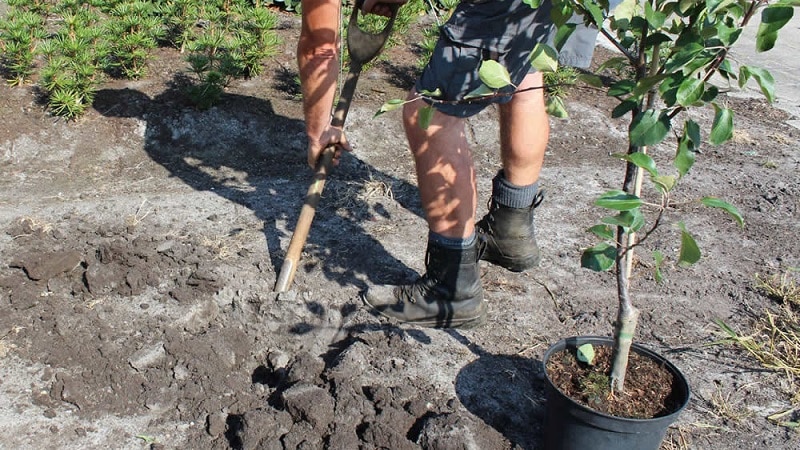
Advantages and disadvantages
Let's highlight The main advantages of planting apple trees in the spring:
- there is no threat of frost damage;
- the soil is saturated with moisture;
- Over the summer, the seedling will take root well and become stronger, and will subsequently overwinter successfully;
- Buying a seedling with blossoming leaves in the spring allows you to assess its condition.
Minuses:
- mandatory regular watering (especially when planting in the southern regions): the spring sun quickly dries out the soil, and the root system of the seedling is undeveloped, so if there is a lack of moisture, it will die;
- return frosts can damage budding buds;
- higher price of seedlings.
Thus, spring planting is recommended for central and northern regions, autumn planting for those where the weather is mild and humid during the cold season.
Interesting things on the site:
Deadlines
Spring planting of apple trees in the south is carried out in mid-April, in the middle zone - at the end of April, in Siberia and the Urals - in mid-May. At this time, the soil is already well warmed up, but still saturated with moisture.
The lunar sowing calendar helps to choose successful days for planting fruit trees.
Such days are considered a favorable period for this in 2020:
- March - 3–7, 10–12, 24-25;
- April - 12-13, 20-22, 27-30;
- May - 18-19, 24-26.
Unfavorable:
- March - 13–15, 19, 27-28;
- April - 9–11, 14, 23-24;
- May - 7-8, 12-13, 20-21.
Selecting a location
When choosing a location for an apple orchard take into account the type of tree, its characteristics and area of the site. In particular, it is important to know the level of groundwater. Tall varieties, reaching a height of 6–8 m, are suitable for areas with low groundwater levels (at least 3 m). Such trees are planted at a distance of 4–6 m from each other.
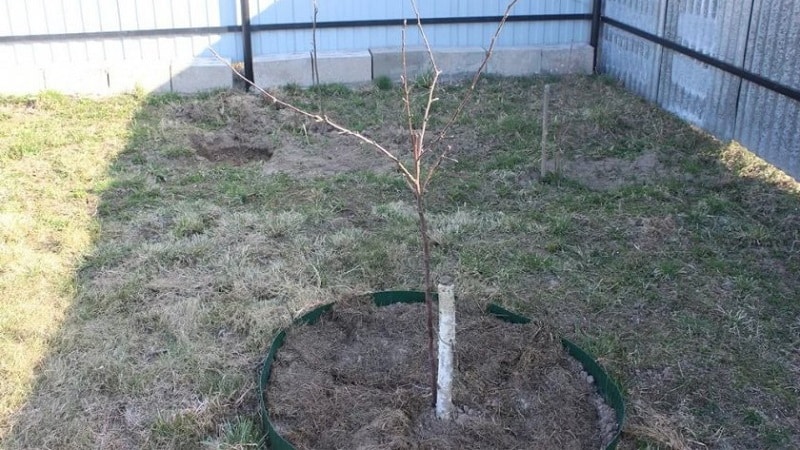
Medium-sized apple trees are planted in areas with a groundwater level of 2-2.5 m, low-growing or dwarf varieties (2-3 m in height) - about 1.5 m.
Reference! Depending on the variety, it is determined on which side of the plot to place the seedlings.Tall plants are placed in the northern part, short ones - in the southern part.
For apple trees, choose an open, spacious and sunny place, on which no trees had grown before. Pear, plum, and rowan are considered favorable neighbors.
Preparation of seedlings and pits
 For planting, choose a two-year-old tree 60–70 cm high with at least 3 shoots. Annual seedlings are also used, but they take root only if they are sufficiently developed. The root system of a regular plant has 3 branches 30–35 cm long or more.
For planting, choose a two-year-old tree 60–70 cm high with at least 3 shoots. Annual seedlings are also used, but they take root only if they are sufficiently developed. The root system of a regular plant has 3 branches 30–35 cm long or more.
The future crown of the plants selected for planting is formed. Using a sharp knife or pruning shears, cut off the top of the tree, removing a few buds (side branches will grow from them). The buds that look up are removed. Leave 5-6 healthy buds, looking sideways and spaced evenly along the length of the seedling. These will form skeletal branches.
Directly Before planting, seedlings are placed in water for a day.
Important! The vast majority of apple trees require another variety growing nearby for pollination. And although some plants self-pollinate, they all produce more fruit when next to another tree. In this case, apple trees must bloom at the same time in order to pollinate each other.
Planting pit
The hole is dug 1-2 weeks before planting. The diameter of the hole for tall and medium-growing varieties is 90–100 cm, the depth is 60–70 cm, for dwarf varieties it is 90 and 50 cm, respectively. When digging a hole, the top fertile layer of soil is set aside. If the soil is clayey, add sand (2:1); if sandy, add humus and peat (2:1:1).
Attention! A properly prepared planting hole provides the tree with nutrients for several years. Therefore, even for small annual seedlings, they dig a large hole.
The bottom of the dug hole is loosened by 20–30 cm and filled with a mixture from the top fertile layer of soil, humus, peat, compost (in a 1:1 ratio) and mineral fertilizers (6 handfuls of superphosphate and 1 handful of potassium sulfate). The hole is filled with soil up to a height of 15–20 cm, leaving a reserve for soil shrinkage. If the soil is dry, water it with water.
Step-by-step landing guide
Prepared the pits are left to settle for a couple of weeks. After this time, they begin planting. In a pre-prepared hole, make a hole the size of the roots of a seedling or earthen ball.
Step-by-step planting instructions:
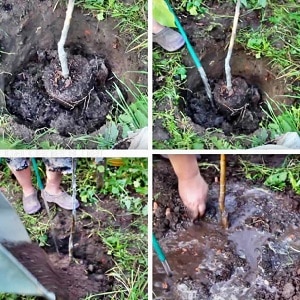 A hill about 15–20 cm high is formed at the bottom of the hole.
A hill about 15–20 cm high is formed at the bottom of the hole.- A tree support (wooden peg) is installed in the center.
- A seedling is placed nearby, its roots spread evenly in a circle.
- The roots are covered with fertile soil and carefully compacted so that there are no voids left. At the same time, make sure that the base of the tree (the junction of the trunk and the root system) is several centimeters above ground level. This will prevent the plant from subsiding.
- The apple tree is tied to a peg to prevent strong winds and precipitation from tilting it.
- The plant is watered with water (3-4 buckets for each seedling).
The top layer of soil is additionally mulched with straw or humusto retain moisture and prevent weed growth.
Read also:
Landing nuances
When determining the timing and technology of planting, take into accountwhat kind of root system the seedling has: open or closed.
If you buy seedling with open root system (the roots are not hidden in a container or other container), plant it in late April - early May or late September - early October. Seedlings with a closed root system (in a container) are not so demanding in terms of planting. They are planted even in summer.
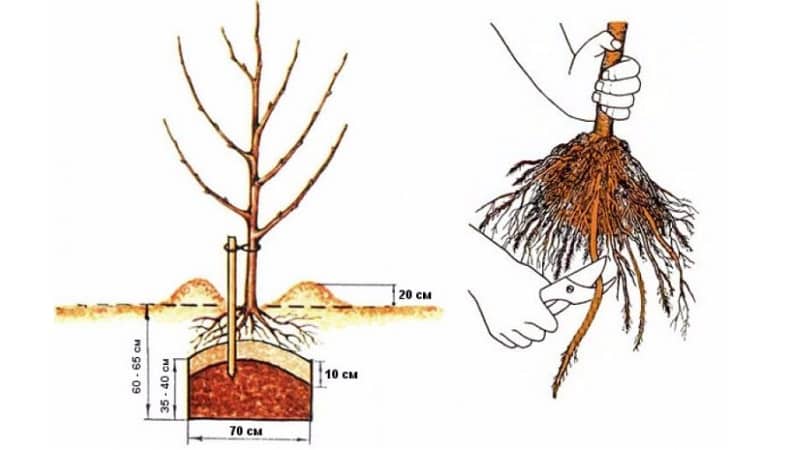
A plant with an open root system is carefully inspected, removing damaged roots. When planting, the tree is placed on a formed mound of earth on the north side of the stake so that the root collar is 5-6 cm above the ground level. The roots are evenly distributed, watered abundantly and sprinkled with the reserved soil. After 5–10 minutes, the soil is lightly compacted in the center and more firmly at the edges so that small roots adhere more tightly to it.
When planting an apple tree with a closed root system The bottom of the hole is made in the form of a flat platform so that a ball of earth can be placed. In this case, the root collar is also placed 5-6 cm above ground level. The seedling is watered, the hole is filled with soil and compacted.
Further care
Caring for apple trees after planting involves: regular watering, mulching the top layer of soil, protection from pests and frost in winter.
Watering
Young trees require more moisture than mature trees with a well-developed root system. Therefore, regular watering is the key to the survival of a seedling in a new place. The frequency of watering is affected by the type of soil: clay soils are watered less frequently, but more abundantly, than sandy soils.
The first watering is carried out immediately after planting. The soil is moistened to a depth of 40 cm to eliminate air pockets and ensure soil density. After this, the seedlings are watered abundantly 2 times every 7 days for the first few weeks until the root system takes root.
Important! Overmoistening of the soil is detrimental to young trees. Watering too frequently will cause the leaves to turn yellow and fall off.
If the top 5–10 cm of the soil is dry, then it’s time to water the apple trees. A small stream of water from a garden hose left in the root zone for several hours is preferable to watering from a bucket.

Mulching
After water is absorbed into the hole within a radius of 0.5 m, the soil is mulched with a thin layer of humus or peat chips. The purpose of this procedure is to prevent moisture evaporation and control the growth of weeds.
In autumn, after the soil freezes, the mulch layer is increasedto protect the root system from freezing.
Protection from frost, diseases and pests
In addition to insulating the root system, in regions with frosty winters, young trees are tied with spruce branches, paper, etc., to protect the bark from frost and sunburn in early spring.
Apple trees are susceptible to pests and diseases. Keeping the area around the tree clean by removing weeds and cleaning of plant residues reduces the risk of the spread of diseases and insects.
Tips and tricks
If you don't have much space in your garden plot, take a closer look at dwarf varieties apple trees The achievements of modern breeding make it possible to grow short and compact trees, which at the same time give a decent harvest. In addition, small plants are easier to care for and are more resistant to disease.
Another important tip is not to neglect annual tree pruning.. It stimulates active fruiting, helps to avoid crown thickening and the development of diseases. Without regular pruning, the apple tree will produce too many fruits, resulting in poor flavor and weakening the tree.
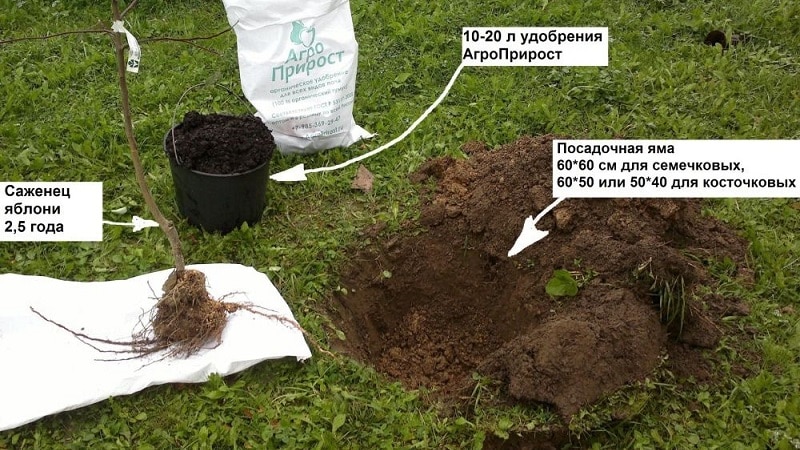
Common Mistakes
Let's list the most common mistakes made when planting plants:
- Planting young seedlings in a newly prepared hole with soil. Apple trees are planted a couple of weeks after preparing the hole (or even better, a month later), when the soil has settled and settled. This is important for proper placement of the root collar.
- Deepening the root collar. This error follows from the first one. The root collar (the boundary between the root system and the trunk—the place where the color of the bark changes from greenish to light brown) is located at soil level or 2-3 cm above it.
- Confusion of the concepts “root collar” and “grafting site”. Seedlings purchased from a nursery are usually grafted. It is made on wild ground, 4–8 cm above the root collar. Beginning gardeners often incorrectly determine its location, and therefore plant plants by burying them in the soil up to the grafting site.
- Shallow landing. Insufficiently deep planting leads to drying out of the root system and poor plant survival. Spring shallow planting of seedlings is especially dangerous in dry years.
- Adding a large amount of mineral fertilizers to the planting hole. From their excess, bacteria, which must process nutrients into a form accessible to plants, die. Also, do not add fresh or slightly decomposed manure to the soil. With a lack of oxygen at the bottom of the pit, manure decomposes poorly, releasing ammonia and hydrogen sulfide, which inhibit the root system of plants.
Conclusion
Proper spring planting of an apple tree is the main condition for its future full growth and speedy fruiting. When planting, it is important to prepare the holes in advance and correctly place the seedlings in them.Caring for plants involves regular watering and protection from diseases and pests.